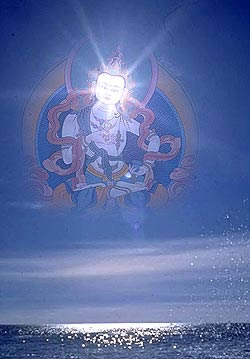
When we're watching a movie in a theater, we can relax and enjoy the show because we know it's an illusion. This magical display that we're watching is the result of a projector, film, light, screen, and our own perceptions coming together. In separate momentary flashes of color, shapes, and sound, they create an illusion of continuity, which we perceive as characters, scenery, movement, and language. What we call "reality" works much the same way. Our ability to know, our sense perceptions, the seeds of our past karma, and the phenomenal world all come together to create our life's "show." All of these elements share a dynamic relationship, which keeps things moving and interesting. This is known as interdependence.This is one of the clearest explanations on these topics that I have ever read. I'm becoming a big fan of this man's writings as I slowly wade through the book.
When we look around us, we can see that nothing exists in isolation, which is another way of saying that everything is interdependent. Everything depends upon an infinite number of causes and conditions to come into being, arise, and fall away moment by moment. Because they are interdependent, things don't possess a true existence of their own. For instance, how could we separate a flower from the many causes and conditions that produce it -- water, soil, sun, air, seed, and so forth? Can we find a flower that exists independently from these causes and conditions? Everything is so intricately connected it is hard to point to where one thing starts and another ends. This is what is meant by the illusory nature of phenomena.
~ Dzigar Kongtrul, It's Up to You
Technorati Tags: Buddhism, Interdependence, Dzigar Kongtrul, It's Up to You, Dzogchen
2 comments:
That is a very clear explanation. Here is the question I have on the whole interdependence thing. A personal experience of interdependence is what brought me to Buddhism, so I trust completely in its truth. However, in thinking of it logically, I see a conundrum. If we take interdependence to its logical extreme, in the direction of "smaller," here's what we get. Flowers are interdependent on water, soil, sun, air, seed, etc. Sun, to examine only one, is interdependent on hydrogren & helium (among other things). Hydrogen and helium are interdependent on the protons, electrons, and neutrons that comprise them. These subatomic particles are interdependent on fermions (quarks & leptons) and bosons. And that is as far as we know. Now, what are these constituent particles interdependent on?
Buddhism handles the idea of causes and conditions by saying that the world goes back an infinite amount of time, without beginning, as nothing can exist without a cause. But can we say that matter gets infinitely small? That there is no truly fundamental particle? Or maybe there is, but what is its cause, then?
From a comparative mythology view of religion, maybe Buddhism effectively models our world in the same way that Newtonian physics models our world. Newton's laws must give way when dealing with the quantum realm, where quantum physics takes over. By the same token, maybe Buddhism (and all other mythological viewpoints) apply to our perceptual world, but perhaps in a different manner to the quantum world.
Thoughts?
Sorry for the double, but I realized after I submitted the previous comment that I was considering fundamental particles as causes, when, in reality, they are not truly causes but compositional pieces. A flower is interdependent on soil, sun, water, etc. But it is interdependent on them based on the processes used by flowers (e.g. photosynthesis and nutrient absorption). So to reconsider my logically extended example, the sun is interdependent not only on the components H & He, but also on the processes by which H fuses into He, releasing nuclear energy. H & He are interdependent not only on their constituent parts, the subatomic particles, but on the strong and weak nuclear forces, and other such things that bring them together to form the elements of H and He. And in the case of the sun, there were other causes that caused those subatomic particles to coagulate near each other, to form a burning ball of golden light. :) To take deeper, maybe fermions and bosons ARE the most fundamental particles (let's say they are, for example). If they are, causes cause them to fuse and repel and spin and whatever to create the H & He that coalesced in proximity to form our sun at a certain point in our universe's history. As long as there are causes that can cause fermions & bosons to be created and destroyed and/or transformed, then karma, cause & effect, still applies.
So, in effect, my analysis in the first comment was wrong. :)
Post a Comment